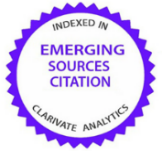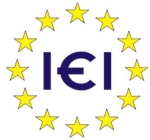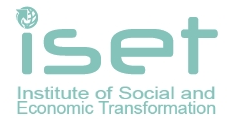Tourism cluster as a form of innovation activity
Abstract
Introduction. At the moment, innovation development is among key priorities in the development of Latvian economy. According to European Innovation Scoreboard assessment, Latvia joined the group of Moderate Innovators in 2016. However, its level of innovation effectiveness only reached 54% of the average EU index. That said, it has to be noted that enterprises that are innovation active in the service industry only account for 23.4%. In view of this, diverse forms of innovation activity and clusters in particular, have become more and more relevant. In 2006 European Competitiveness Council defined clusters as one of nine priorities aimed to promote and develop innovations. According to the European Commission, clustering is a key factor for successful innovation and enhanced competitiveness.
Aim and tasks. The subject matter of this article are tourism clusters as a type of innovation activity.
Results. Scientific research as well as practical experience of a number of countries have shown that cluster approach in tourism business is an effective instrument to enhance competitiveness both nationwide and at the level of an industry.At the present time, entrepreneurs are facing serious difficulty in converting ideas into new products and services. This is true of the national economy as a whole as well as particular industries. That said, the primary objective is the development and implementation of a program aimed at the cooperation of a wide range of social partners involved in innovation activity, who are capable of facilitating the enhancement of economic effectiveness.
Conclusions. The development of tourism sectoris regarded as a priority of Latvian economy. According to Central Statistical Bureau of Latvia, tourism is a major factor of Latvia’s economic development, an important source of export revenue, and a key factor of GDP growth. The development of Latvian tourism industry is part and parcel of global tourism market. Latvia has a strong potential for the development of business and health tourism. However, Latvia’s climate, its geographic position and the lack of world-famous architecture have an unfavorable effect on its tourism development opportunities. This is the reason why it is essential for Latvia to spur innovative activity in tourism industry with a focus on clustering. Creation of new clusters in tourism industry, such as business tourism cluster as an example, as well as the implementation of formerly declared goals related to the existing clusters, will help to meet some of the objectives.
Keywords:
cluster, innovation activity, tourism.References
2. Petrova, M., Tepavicharova M. & Boykova L. Improvеment of the Efficiency and Competitiveness through the Implementation of Benchmarking in the Organizations. Bulletin of Ablai Khan KazUIRandWL series ÏNTERNATIONAL RELATIONS and REGIONAL STUDIES”, ISSN 2411-8753, 1 (27) 2017, 5-6, 79–86.
3. Uteubayev, T. & Petrova M.M., The development of human potential in Kazakhstan’s innovation economy, Business Management, issue 4, Tsenov Academic Publishing House, Svishtov, 2017, 75–89, ISSN: 0861 6604-Print; eISSN: 2534-8396.
4. Adamisin, P., Pukala, R., Chovancova, J., et al. (2016). Fullfilment of environmental goal of the Strategy Europe 2020. Is It Realistic? 3rd International Multidisciplinary Scientific Conference on Social Sciences and Arts, SGEM 2016, 24-30 August 2016, Albena, Bulgaria, Political Sciences, Law, Finance, Economics and Tourism Conference Proceedings, Vol. II, Book Series: International Multidisciplinary Scientific Conferences on Social Sciences and Arts, 181–190.
5. Adamišin, P., Vavrek, R. & Pukala, R. (2015). Cluster analysis of Central and Southeast Europe via selected indicators of sustainable development, 15-th International Multidisciplinary Scientific Geoconference SGEM 2015, 18-24 June 2015, Albena, Bulgaria 2015, Ecology, Economics, Education and Legislation, Vol. III, Book Series: International Multidisciplinary Scientific GeoConference-SGEM, 135–140.
6. Petrova M., Buzko I. & Dyachenko Y. (2018). Cognitive, Intelligence Technologies and Economical Foundations of Teaching of International Economical Relations and Tourism. 17th International Scientific Conference Engineering for Rural Development, 23-25 May 2018. Jelgava, Latvia, 1102–1106, DOI: 10.22616/ERDev2018.17.N170,
7. Petrova M.M., Minchev N. & Diachenko, Y. (2016). Modern information technologies as an opportunity for development and integration of innovative small and medium enterprises in clusters. Balkan and Near Eastern Studies in Social Sciences, 2016:2 (02), 69–75.
8. Sushchenko O. & Petrova M. (2017). Internet Marketing as a Tool of Tourism Enterprise Strategic Management. Modern Problems of Enterprise Management: Theory and Practice: materials International sciences - practice conference, 30-31 March. Kharkiv, Simon Kuznets Kharkiv National University of Economics, 302–305
9. The Global Competitiveness Report (2018). Retrieved from www.weforum.org/reports/the-global-competitveness-report-2018.
10. Porter, M. (2016). International Competition. Competitive advantages of countries.
11. Marshall, A. (1993). Principles of economic science.
12. Porter, M. (1998). Clusters and the new economics of competition. Harvard Business Review, Vol. 76, No. 6, 77–90.
13. Porter, M. (1990). The Competitive Advantage of Nations. The Free press. New York, 149.
14. UNIDO (2001). Development of Clusters and Networks of SMEs: The UNIDO Programme. Retrieved from http://www.unido.org/ doc/351428.htmls.
15. European Commission. (2002). Regional Clusters in Europe: Observatory of European SMEs 2002. Luxembourg, European Communities.
16. Latvian Investment and Development Agency. (2007). Cluster program. Retrieved from http://www.liaa.gov.lv/uploaded_files/ES_strukturfondi/Klasteru%20programma%2011.12.2007.pdf.
17. Volkova, T. (2008). Cluster development potential in Latvia. Retrieved from http://www.kvestnesis.lv/index.php?menu=DOC&id=178565.
18. Travel & Tourism Competitiveness Index (2017). Retrieved from http://www.weforum.org/reports/the-travel-tourism-competitiveness-report-2017.
19. Central Statistical Bureau (2018). Retrieved from http://www.csb.gov.lv/statistikas-temas/inovacijas-galvenie-raditaji-30336.html.
20. Eurostate (2016). Retrieved from http.eurostat.ec.europa.eu/portal/page/portal/statistics/search_database.
21. Latvian Investment and Development Agency (LIAA). Retrieved from http://www.liaa.gov.lv/lv/uznemejdarbibas-veicinasana-un-inovacijas.
22. Baltic Business Outlook (2018). Retrieved from https://www.seb.lv/ru/node/9282.
23. Kvach, Y., Koval, V., & Hrymaliuk, A. (2018). Tourism and hospitality industry in the context of global economic development. Economics. Ecology. Socium, 2(4), 11–21. doi.org/10.31520/2616-7107/2018.2.4-2.
24. Koval V., Polyezhaev Y., Bezkhlibna A. (2018). Communicative competences in enhancing of regional competitiveness in the labour market. Baltic Journal of Economic Studies, 4, 5, 105–113. doi: http://dx.doi.org/10.30525/2256-0742/2018-4-5-105-113.

This work is licensed under a Creative Commons Attribution-NonCommercial 4.0 International License.
If the article is accepted for publication in the journal «Economics. Ecology. Socium» the author must sign an agreementon transfer of copyright. The agreement is sent to the postal (original) or e-mail address (scanned copy) of the journal editions.






















